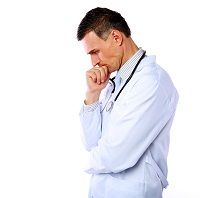Article
Only a Small Percentage of Hypogonadal Men Are Receiving Needed Treatment
Author(s):
A number of widely reported studies have concluded that the rapid growth in testosterone therapy prescriptions has led to overuse, but an analysis published in Urology indicates that underuse may also be a problem.

A number of widely reported studies have concluded that the rapid growth in testosterone therapy prescriptions has led to overuse, but an analysis published in Urology indicates that underuse may also be a problem.
Researchers obtained the records of all 9,176 men aged 18 to 85 who got their serum total testosterone levels checked at Chicago’s NorthShore University Health System between 2009 and 2012. The tests found less than 300 ng/dLof testosterone in 3,320 of the men (36%) and revealed that many of these hypogonadal men had severe shortages. Their average total testosterone level was 194.3 ± 64.9 ng/dL.
However, only 17.7% of the men tried testosterone replacement therapy during the study period.
That percentage rose dramatically over the course of the study period. Just 8.3% percent of who were found to be hypogonadal in 2009 received testosterone therapy. By 2012, that figure had increased to 24%.
Still, even after considering both that trend and the potential limitations of their dataset, the researchers reached a conclusion that seems to contradict the common perception that too many men use the hormone: “Although the frequency of testosterone replacement therapy is increasing,” they wrote, “only a small percentage of hypogonadal men are actively undergoing treatment.”
Other findings from the new analysis were more in line with the conclusions of other recent studies.
Follow-up testing, for example, often went undone. Just 40% of the men who received replacement therapy underwent either a complete blood count or a liver function test within 180 days of their initial testosterone test. Just 49% of them even got their testosterone levels checked a second time.
Another potentially troubling finding was the relatively common use of replacement therapy in men of reproductive age: among those men aged 18 to 35 years who were found to have low testosterone levels, 4.8% of them received supplements.
“A significant proportion of men of reproductive age are being treated with significant impacts on potential fertility. Less than half of the patients treated are being monitored appropriately after testosterone replacement,” the study authors wrote. “This highlights the importance of further education for providers prescribing testosterone replacement.”
Some of the apparent disagreement between this study and other recent research may be illusory.
Many of those studies have focused on the use of therapy in patient populations that should not receive it (ie, men who never got their testosterone levels measured or men with normal testosterone levels). Their findings of overuse (among men who should not receive testosterone) are perfectly compatible with the new study’s finding of underuse (among men who should).
Other earlier studies, on the other hand, have focused on the use of testosterone in older men whose low testosterone levels seem to stem from nothing but age.
Such studies have led the US Food and Drug Administration to warn physicians against excessive prescriptions. The agency announced in March that it would require product labels to state that treatment is only approved in men whose hypogonadism stems from disease or injury rather than normal aging.
The problem, however, is determining what constitutes a “normal” decline in testosterone.
Ongoing research may soon provide that answer and demonstrate whether too many older men are using testosterone — or too few. Many of those same studies may also determine whether testosterone replacement therapy is a safe and effective way to counter a variety of age-related issues ranging from decreased libido and fatigue to cognitive decline.




